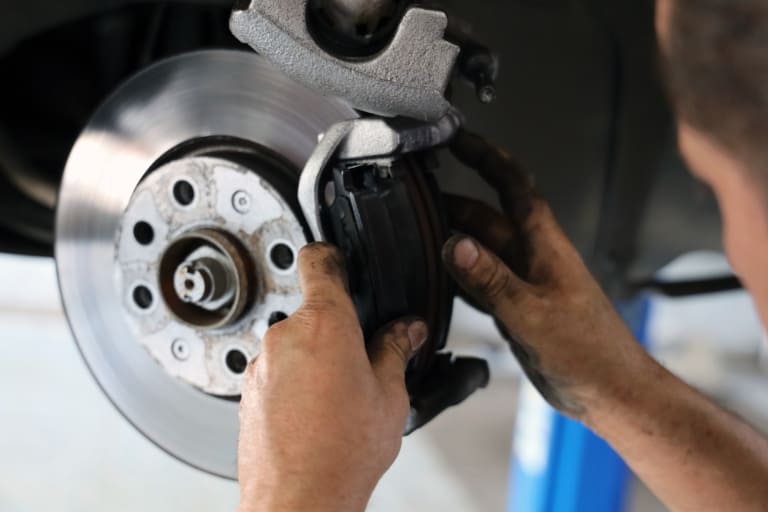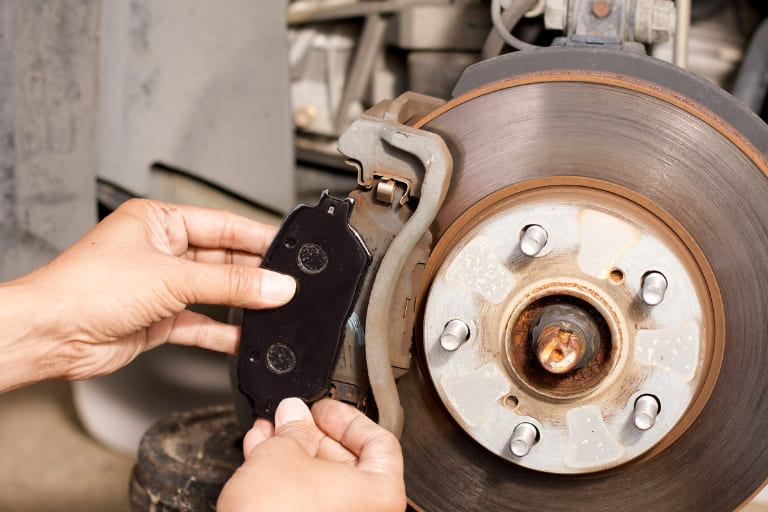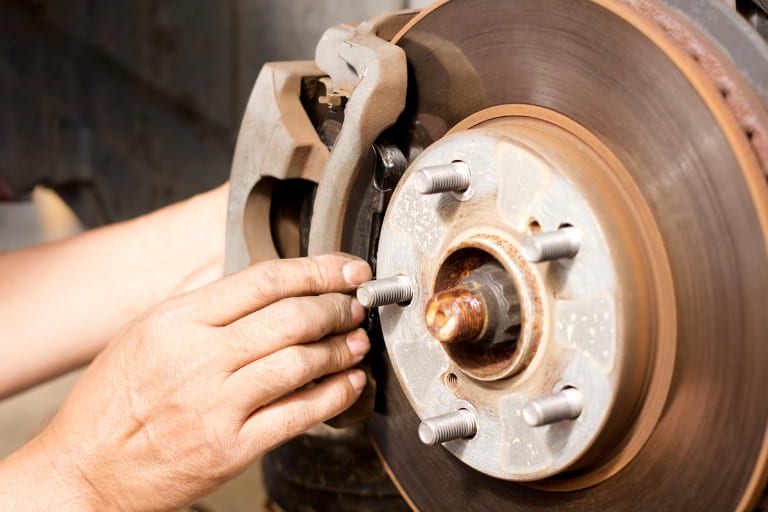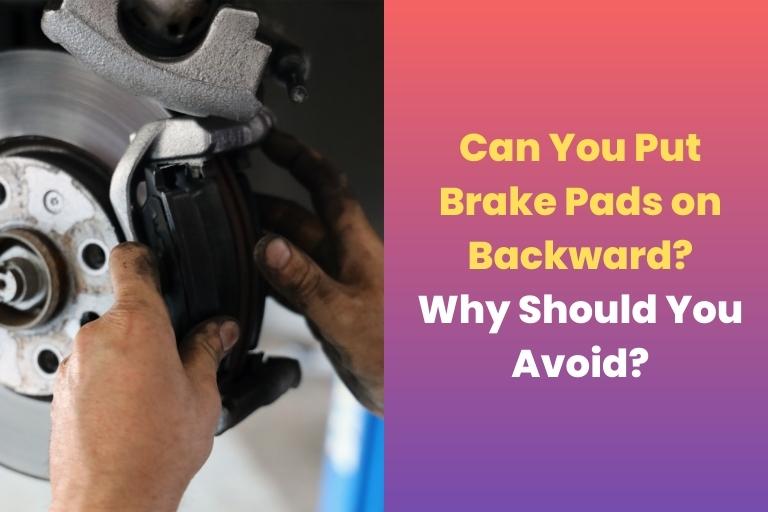If you’ve ever been tinkering beneath the hood of your beloved vehicle, you’ve probably come across the intimidating process of changing brake pads. But here’s the thing: have you ever wondered whether you could install those brake pads backward?
Is it possible to put brake pads backward? It’s an issue that has perplexed many do-it-yourself mechanics, and we’re going to throw some light on it today. So strap in, and let’s get started!
Contents
- 1 Can You put brake pads on backward?
- 2 What happens if you put brake pads on backward or upside down?
- 3 How do I know if my brake pads are installed correctly?
- 4 Can I Install Break Pads Wrong?
- 5 Is there a difference between inside and outside brake pads?
- 6 Does it matter which way brake pads go on?
- 7 Conclusion
Can You put brake pads on backward?
No. Brake pads are designed to fit in a certain way and cannot be put in the opposite direction. They feature a specific orientation with friction material designed to face the rotor for the best performance. Incorrect installation might result in diminished braking efficiency and related safety issues.
What happens if you put brake pads on backward or upside down?

Installing brake pads backward or upside down can lead to uneven wear, impaired vehicle safety, and decreased braking performance. Brake pads are meant to fit in a precise orientation, and improper installation can result in difficulties such as uneven wear, longer stopping distances, poorer control, and lower braking efficacy, posing road safety hazards. For appropriate brake pad installation, always follow the manufacturer’s recommendations.
Uneven wearing of the brake pads
Brake pads that are fitted backward or upside down might wear unevenly. The friction material is meant to make particular contact with the rotor, and the wrong installation might result in uneven wear. This can result in inconsistent braking performance, decreased stopping power, and premature wear on other brake components.
Compromise in car safety
Your safety on the road is critical, and badly installed brake pads might jeopardize it. Brake pads are an important component of your vehicle’s braking system, and if they are not put correctly, they may not perform properly. This can lead to longer stopping distances, less control, and an increased chance of collisions, placing you and your passengers in danger.
Less efficient braking system
Brake pads are intended to function with the rotor to deliver the best possible braking performance. They can interfere with the rotor’s ability to grip and stop the car if fitted backward or upside down. As a result, braking performance, response, and wear on other brake components may suffer.
How do I know if my brake pads are installed correctly?
If your brake pads are placed incorrectly, you may experience the following symptoms:

Uneven wear
Incorrectly placed brake pads can cause uneven wear, with one side wearing out quicker than the other. On the brake pads, this can be visible as unequal thickness or uneven wear patterns.
Squeaking or squealing sounds
If you hear a squeaking or squealing noise coming from your brakes, it might indicate poor installation. For example, if the brake pads are fitted backward or upside down, the friction material may not make appropriate contact with the rotor, resulting in noise.
Reduced braking performance
If you observe a reduction in braking performance in your car, such as longer stopping distances or less responsive braking, it might be due to incorrectly fitting brake pads. For example, if the brake pads are not correctly aligned with the rotor, they may be unable to create enough friction for efficient braking.
Vibration or pulsation
If you experience vibrations or pulsations emanating from the brake pedal when you press the brakes, this might be an indication of poorly mounted brake pads. Uneven pressure on the rotor caused by improperly placed brake pads might create vibrations or pulsations when braking.
Visual inspection
Examining the brake pads visually might reveal whether or not they were put properly. The friction material should face the rotor, and the brake pads should be centered within the brake caliper, with no overhanging edges or misalignment.
Can I Install Break Pads Wrong?
It is critical to ensure that brake pads are properly placed in order to preserve maximum braking performance and safety. It is possible, however, to install brake pads improperly.
For example, you may install them backward, upside down, or misalign them with the rotor. This can result in uneven wear, decreased braking performance, squeaky noises, vibrations, and other problems.
As a result, it’s critical to follow the manufacturer’s instructions and get expert assistance if you need clarification on how to properly replace brake pads. After all, your safety and the safety of others on the road are at stake!
Also, Check: Are Brake Pads Interchangeable?
Is there a difference between inside and outside brake pads?
Yes. There can be a difference between inside and outside brake pads in some brake systems. To ensure proper fitment and performance, the inside and outside brake pads may have different shapes, features, or markings.
One common difference is the chamfer or bevel on the edge of the brake pads. Some brake pads may have a chamfered or beveled edge on one side, meant to face the rotor on the inside or outside of the caliper. This helps with proper alignment and contact with the rotor during braking.
Another difference could be markings or indicators on the brake pads that specify which side should face the rotor. These markings or indicators may be manufacturer-specific and vary depending on the brake pad design.
It’s important to carefully follow any manufacturer’s instructions, markings, or indicators to ensure that the brake pads are installed correctly with the proper orientation. Installing brake pads in the wrong orientation can reduce braking performance, uneven wear, and potential safety risks.
Suppose you need clarification about the difference between inside and outside brake pads or how to install them properly. In that case, it’s best to refer to your vehicle’s manufacturer’s instructions or consult a qualified mechanic for guidance.
Also, Check: Brake Shuddering After New Rotors and Pads
Does it matter which way brake pads go on?

Yes. The orientation of the brake pads is important. Brake pads are intended to fit in a precise orientation for best performance and safety. Incorrectly installed pads can cause various problems, including uneven wear, poor braking effectiveness, and safety hazards.
Typical brake pads include a friction substance on one side that makes contact with the rotor while braking. When placed, this friction substance should face the rotor. Some brake pads may also feature chamfers or bevels on specific edges to face the rotor in a specified orientation.
Furthermore, certain brake pads may include markings or signs indicating which side should face the rotor. Adherence to these indications or directions is critical to ensure proper installation.
Installing brake pads backward or upside down might result in lower braking performance, increased wear, noise, vibrations, and other problems. As a result, if you need clarification about the proper orientation for replacing brake pads, it’s critical to follow the manufacturer’s instructions or get expert assistance carefully. Brake pads that have been properly placed are critical for safe and effective braking.
Related Articles:
- Does the Emergency Brake Lock All Wheels?
- Why Does My Car Shake After Changing the Brake Pads?
- How to Install Anti-Rattle Clips on Brake Pads
- How Long Can You Drive Without Brake Pads?
- Brake Pad Lifespan Explained
- How to Fix New Ceramic Brake Pads Making Grinding Noise
- Ceramic vs. Semi-Metallic Brake Pads: Which is Better?
- Ceramic vs OEM brake pads
- Why Are My Brakes Grinding After New Pads And Rotors
- Ceramic vs Organic Brake Pads
- Ceramic vs Carbon Fiber Brake Pads
Conclusion
In conclusion, properly fitting brake pads is critical for maintaining maximum braking performance and safeguarding the safety of your vehicle and passengers. Putting on brake pads backward or upside down, or failing to line them with the rotor correctly, can result in uneven wear, reduced braking performance, and road safety issues.
Following the manufacturer’s instructions or seeking expert assistance is critical to clarify the proper orientation for fitting brake pads. Please take note of any marks, signs, or unique characteristics on the brake pads that indicate their right position.
Installing brake pads properly will help prevent problems in the future and guarantee that your braking system operates optimally. Remember to consider the significance of good brake pad installation for your vehicle’s safety and dependability.
References:
- https://www.tomorrowstechnician.com/top-10-brake-mistakes/
- https://www.autozone.com/diy/brakes/how-to-replace-brake-pads-and-rotors
